-
Posts
1,355 -
Joined
-
Last visited
-
Days Won
1
Content Type
Profiles
News
Store
Forums
Downloads
Events
Posts posted by Barwickian
-
-
24 minutes ago, Doc Democracy said:
A lot of the grunt work you could delegate out on the boards. Am sure you would find plenty of folk happy to generate stat blocks or proof text etc. All for the kudos of being involved. 🙂
Yes, and I'd be very happy for any assistance - a number of people here know Hero far better than I.
One of the things I'd like to do is establish working patterns for sorcery and miracles/prayers for the medieval fantasy theme: distinguishing low magic (which tends to emphasise talismans and raw power words) and high magic (which is a more systemic, intellectual system such as the astral image magic of the grimoire Picatrix and its Arabic original).
Buit the priority is on getting the setting finished, maps done and in all in the publisher's hands before I start thinking of extras.
-
Those interested in a medieval England campaign set during the reigns of Kings Richard and John might be interested to know I'm working on a setting book for Chivalry & Sorcery entitled Sherwood. As well as C&S rules it will have an inbuilt system based on Colin Speirs' rules-light Essence Core and stats for HârnMaster. We've no plans to include Hero stats in the book, but as an old Hero fan I'd like to do a free PDF appendix with Hero stats (note that 'like' is not the same as 'definitely will'). Either way, setting information will far outweigh rules information.
You can see much of the raw research for the project on my World Anvil site, Fabula Mundi.
The baseline setting is built as far as possible on detailed historical and archaeological research. The setting covers everywhere from York and Skipton to the north and Lichfield and Grantham in the south, including the whole of Nottinghamshire and Derbyshire, and parts of Lincolnshire (including Lincoln), Staffordshire and Leicestershire. The area is chosen such that the published map will print on A0 paper (c. 33 inches by 48 inches) at a scale of 2 miles to the inch.
The setting is being written with three primary modes in mind:
Historical - the baseline for the setting. As much historical and archaeological detail as I can squeeze in and make interesting. I'm knowingly allowing only three anachronisms, which I'll explain below.
Medieval Fantasy - the historical setting with the prodigies and wonders written about by chroniclers of the day: devils, revenants, sorcerers (low and high magic), saints' miracles, werewolves, and things 'neither of heaven nor of hell' (the fey, but of the medieval variety not the early modern variety).
Romance - modern ideas overlaid on the historical setting, such as the modern versions of Robin Hood, Saxon rebels versus Norman masters, powers of light and darkness, pagan survivals and so on. Think Ivanhoe, any Robin Hood film or book, and Graham Staplehurst's Robin Hood (ICE), or the Robin of Sherwood TV show that inspired it.Within that there's guidance for several themes: the nobles campaign, the urban/merchant campaign, the outlaw campaign, the agent campaign (PCs working as troubleshooters for the crown, church or a great noble), and a little guidance on specialised campaigns (the monastic and the village life campaigns).
Known anachronisms: The Trip to Jerusalem pub in Nottingham claims to date from 1189 and to have been a meeting place for crusaders heading out on Richard's Crusade. The first recorded pub on the site was in the 17th century, when it was known as The Pilgrim. Nottingham's two other pubs that claim to be medieval, The Bell and the Salutation. are in buildings dendro-dated to the 1440s. The Salutation claims to date from 1240, but its first recorded mention is in 1414, when it was known as The Archangel Gabriel Salutes the Virgin Mary. And that is a pub name I definitely want in the setting. Since I'll be including the Sal, it seems churlish to exclude the Trip and the Bell.
The attached map is a reduced-scale work in progress. It's built in QGIS. I haven't included the villages in this version as they clutter too much at this resolution. I've a lot more information than I can put on to the printed map, so things like feudal holdings, parish boundaries, rural deaneries and peculiars and so on, will likely be done as individual maps in relevant chapters. I plan to release the map alongside the book as a layered PDF, allowing people to turn the various details on and off.- Doc Democracy, Old Man, assault and 3 others
-
 6
6
-
The PDF edition of the new edition of Chivalry & Sorcery is now available on drivethruRPG.
https://www.drivethrurpg.com/m/product/293870
There is a detailed review of the game here:
https://www.savevsplayeragency.net/2019/12/23/review-chivalry-sorcery-5th-edition-pdf/
-
Several of Guy Gavriel Kay's books are set in a fantasy world without magic, drawing heavily on medieval history. A Song for Arbonne draws its inspiration from the troubadours of Languedoc and the Albigensian Crusade; Lions of Al Rassan from El Cid and the Reconquista.
To some extent all historical fiction is fantasy, as it's a fictionakisation of particular events. Some invent fictitious locations - Ken Follett's Pillars of the Earth is notable; the town of Kingsbridge is fictional and loosely located somewhere in southern England. I pity the place - nearly every bad thing that happened anywhere in the 12th century Anarchy happened to Kingsbridge in that book.
-
2 minutes ago, Lord Liaden said:
While Aarn has the reputation for being the largest city in Ambrethel, for big-city adventure I find the Free City of Tavrosel, in Mhorecia, to hold more interesting potential.
You've convinced me. No colossus can replace that east-meets-west vibe.

-
I use Tasha's Ultimate Sheet, which exports to HTML, then print it to PDF.
It's worth noting that Chrome doesn't recognise page breaks, which leads to messy PDFs. Instead, open the HTML file with Firefox and print to PDF from there. Each page is nicely preserved.
-
One magic system I've used for divine magic is to have effects powered only by an END Reserve that will only recharge while the character is performing religious acts, such as prayer. I did this specifically to emulate HarnMaster's ritual and piety point system, and to give divine magic a very different flavour to arcane magic.
You coud vary is somewhat - recovering END only while on ground consecrated to the character's deity, for example (though one might then allow a specific temporary Consecrate ritual which costs no END but requires significant extra time so you can set up a temporary shrine where you stop to camp, but can't recharge your reserve in combat).
-
On 8/30/2019 at 6:31 PM, akrippler said:
Under "fighting" then "attacking individuals" its stated that a unit cannot attack an individual character. However under "prominent characters" in "combat" its states that if a unit "attacks an individual character back" it should be resolved without unit modifiers. How would you interpret this? Perhaps a prominent character can only be attacked if he attacks a unit?
Under "determining damage" its states you should subtract the defenders unit modifier from the attackers with a minimum of 0. however under "prominent characters" when referencing an individual character attacking a unit it states he might not be able to do damage because of the unit modifiers, shouldn't it be a minimum of 0 as well?
lastly aoe's are never mentioned save for the fact that they could possibly hit every character. so i need opinions on if you guys think they should do extra damage to a unit, and how youd math it out.
Re: attacking individuals. Under "attacking individuals" the rules note that the ban on attacking individuals is for ease of play.
Most actions for prominent individuals are not attack options, but leadership. inspiration and intimidation. However, the rules note that if a prominent individual chooses to attack a unit, it is treated as a unit of one person (ie, the unit it is attacking can attack it back).
Determinging damage from individual attacks - yes, the rules note that under most circumstances the Unit Modifer should not be less that 0, in order that a smaller unit may damage a larger one. However, it goes on to note that the GM may allow Unit Modifiers of less than 0 in order to keep smaller units from having too great an impact. In the case of an individual, no matter how prominent, attacking a large unit, that would seem appropriate.
AOEs are mentioned in Megascale and Battle Scale in the Magic in Mass Combat section. It suggests the way to build a spell to affect an entire unit is to use Megascale.
No mass combat system I'm aware of segues nicely between personal scale and unit scale. There's always some clunkiness and edge cases.
Hero System mass combat offers several options - treating prominent individuals as one-person units, using noteworthy events for individuals, and having personal scale combat in a mass combat environment. None of these is without issues - but those issues are much easier to resolve if one remembers that the player characters are the protagonists: it's their story that matters. -
It's worthwhile noting that the TA resources go much further than the TA setting book, Fantasy hero Battlegrounds and Nobles, Knights and Necromancers.
Fantasy Hero Grimoire and Fantasy Hero Grimoire II are specifically noted as being the grimoires for Turakian Age - in their spell descriptions (and even names) you'll find snippets of background lore on wizards and the occasional historical events. These were removed (and spells renamed) when the two volumes were combined for the 6th edition Grimoire. Personally, I rather like the fanciful names of the 5th edition grimoires.
Enchanted Items, by Jason Walters, also draws on TA for items' backgrounds. Monsters, Minions and Marauders provides stats for many of the species in the core setting book.
Some published elements of the setting go back further. The Ulronai Warrior-Mage and the College of Warrior-Magery were first detailed in Fantasy Hero Companion II (for 4th edition) back in 1992. Steve is listed as a contributor to that volume.
I must admit, I very much enjoy the Turakian Age. I've set campaigns in Aarn and the Westerlands, and in Mitharia. I've even set the classic Keep on the Borderlands (converted to Hero 6) in the borders between Kirkhovy and Vestria. Like others, I find it has a Greyhawk-ish flavour, though with more plot ideas secreted in its background.
-
I must admit to a personal dislike of theeing and thouing as a faux medieval thing. Mostly because I come from a part of England that still uses thee and thou - and it is the familiar form of the second person singular. You use it with friends and family. As we say, tha thees them as thees thee (you use 'thee' with people who use 'thee' with you, in standard English).
But because it's in the KJV, people think it's polite and quaint.
There has been a lot of streamlining of rules over the years; our mantra with this edition is "rules elegance" - no unnecessary complexity - while increasing the medieval flavour.
-
I ran a game in Bahrain using the free 5th Edition Quickstart rules recently.
Here are the player reactions.
-
Thank you, Doc.
A little update on the Kickstarter campaign. We funded fully in less than 16 hours. The first stretch goal is unlocked, and we're eyeing the second. There's 27 days to go, and I'm hoping we unlock the final stretch goal in that time - that brings a war game back to C&S for the first time since the 2nd edition of 1983.
Three war games in fact, since Ars Bellica includes an abstract pen-and-paper war game for quick battle resolution, a miniature skirmish game and an army-sized miniature war game.
By the way - even if C&S isn't your thing, check out the campaign video. Just the thing for a bit of Fantasy Hero inspiration.
-
The kickstarter for a new edition of the legendary Chivalry & Sorcery is now live.
https://www.kickstarter.com/projects/cns5/chivalry-and-sorcery-the-medieval-role-playing-game
This edition builds and refines the rules presented on the 4th edition, published 19 years ago. Sections on medieval society are greatly expanded, taking advantage of two more decades of historical research.
Judaism and Islam join Christianity in the core rules for the first time, with sections written by members of those faiths who have studied medieval beliefs and practices. Guidelines for creating fantasy religions and pantheons are included.
Alongside fantastical magick, an optional system presents magick from the medieval worldview.
Disclosure: I am involved in designing this edition.
-
On 4/29/2017 at 8:01 AM, Nothere said:
Baron Blixen- If your headed for Kenya and want to try your hand at safari talk to Baron Bor von Blixen-fineke Swiss writer and African big game hunter he organized safaris for many people including Edward Prince of Wales. If you've seen the movie Out Of Africa that was based on his wife's memoires
Precious few heroes from colonial Africa. That Blixen farm in Africa? That used to be my wife's family's land, before colonisation.
-
12 minutes ago, Cassandra said:
The Boss who yells at them for breaking procedure.
The fact that they break procedure. They're cops who don't play by the rules...
-
The core rules base the limitation value of characteristic rolls off skill rolls (they're an additional -0 limitation). They are subject to AP modifiers just the same as skill rolls - so you have a characteristic roll worth -1/4 of you have -1 per 20 AP, -1/2 if it's -1 per 10 AP and -3/4 if it's -1 per 5 AP, exactly like a skill roll.
In addition to the AP penalty, yes, as you noted they can be drained or suppressed, and subject to change environment - just as a skill roll.
If someone wanted by buy an unmodified activation roll equal to their characteristic roll... well, that's an unmodified roll. And if it's above 14-, my answer would be no.
I *think* we're agreeing with each other, but we're coming at it from different angles. (And I'm referring to 6E1 and you CC/FHC, which may phrase things differently even though the rules are the same.) -
5 hours ago, Cantriped said:
Per the table in FHC, the minimum value of Requires A Roll is -1/4. Thus even a 17- Activation Roll is worth -1/4... despite the table otherwise indicating that a 14- (or better I presume) activation roll being a (-1/2) - (-3/4) = +1/4 modifier.
I wouldn't allow the 17- as an activation roll at all. 6E1 says activation rolls above 14- are allowed only with GM permission, and I wouldn't.

Now if it's a skill-based roll, rather than an unmodified activation roll, this is a different matter - yes, it's possible to buy a skill to 17- or better, but it costs points to do so. A minimum -1/4 is perfectly reasonable.
-
-
On 6/6/2018 at 1:20 AM, Funk Thompson said:
Eh, I'm not sure I like that - rules as written or not.
Activation roll of even 17- should be worth *some* limitation, since you can in fact roll an 18.
I'd call it -1/4 regardless of what value the book is giving it.
You have a 0.46% chance of rolling an 18. The guidelines on Limited Power in 6E1 suggest a -1/4 limitation is appropriate for a circumstance that happens around 25% of the time, with "rarely if ever limited" a -0 limitation.
It's your game, though. -
14 hours ago, Lucius said:
My work around was to make all spells draw from a Mana Pool (END Reserve) and put the Requires a Skill Roll on THAT. Then the roll almost never varies (because the penalty is only based on how much END you're using) but you still need to roll for each spell.
That's very similar to how I built Faith-based powers for Hârn - END Reserve, accessed through a Ritual (or whatever power skill you prefer).
I then added a limitation to the END reserve REC: only recovers during religious activities (-1/2). In other words, clerics need to pray, conduct religious ceremonies, accept religious quests, and so on. -
30 minutes ago, megaplayboy said:
I've been there. Learnt to sail around Mull.
-
I don't post very often, but when I do people may have noticed over the years that I favour low fantasy and historical fantasy over the grandeur of high fantasy.
So let me tell you about Barwick-in-Elmet, the Yorkshire village where I grew up. This will explain my username, and probably my low-fantasy preferences.

Before I plough into it, I'll just note that this kind of history isn't unusual to most of us Europeans. Most of our villages date back about thousand years. Fantasy villages written by American designers seem more inspired by the Old West frontier settlements - Hommlet is a classic example. It doesn't look right, it doesn't feel right. It has no history in its design or landscape.
So here's some archaeology, a little history, and an unusual folk custom. I realise this thread is mostly inspirational pictures, but sometimes pictures want context.
The oldest obvious human 'building' in Barwick is a single-vallum, figure-8 shaped Iron Age hillfort known as Wendel Hill. It's never been dated, but the nearby Becca Banks earthworks have been dated to the 1st century AD, probably thrown up to stop the Roman general Agricola and his legion as they marched north (if so, it failed). I suspect the hillfort is up to a century older.
Within the hillfort lies the motte of a late-Norman motte and bailey castle, which we call Hall Tower Hill. The castle - its licence was granted by King Stephen, c. 1150AD, has long since vanished. The castle's bailey was the smaller part of the figure-8 of the hillfort; the larger part became part of peasant tofts (gardens).
Hillfort plan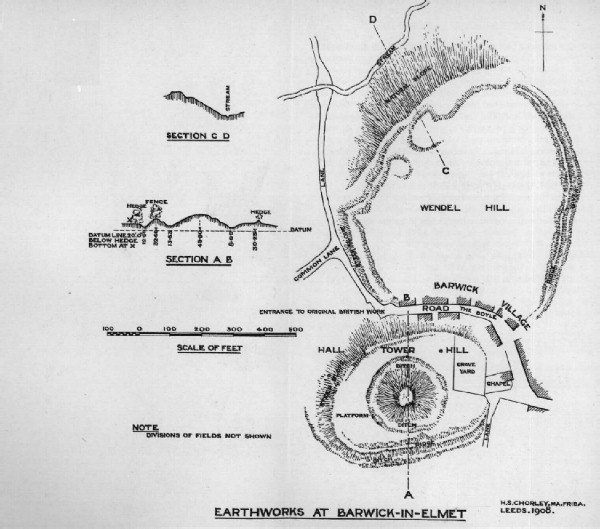
Aerial view - the line of hedges marks the hillfort vallum (bank and ditch).
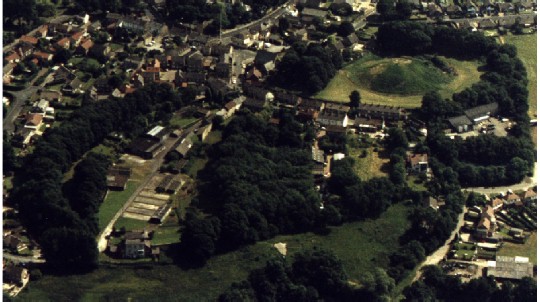
After the Romans left and the Saxons invaded, Barwick was part of the Cambric kingdom of Elmet, part of Hen Ogledd, the Old North (Hen Ogledd's most prominent king was Hen Cwl - Old King Cole of the English nursery rhyme). Along with Rheged, Elmet was one of the last surviving ancient British kingdoms. It finally fell to the Saxon Northumbrian king Edwin in 616. Barwick is sometimes erroneously considered the capital of Elmet, but in truth, no one knows where Elmet's capital was.
After the Saxons, the Vikings came. Barwick lies about 15 miles west of York, a prominent Viking trade town in the 9th and 10th centuries, and the centre of Erik Bloodaxe's 10th-century Kingdom of York. A pair of Viking carvings were incorporated into the 12th century foundations of the village church, All Saints' Church, probably dating from the 10th century. This is one of them.
Barwick is listed in Domesday Book as an outlying settlement of nearby Kippax. Its name, originally bere-wick, means 'beer village', and it's thought it was an outlying hamlet where barley was grown. By the mid-12th century its importance increased, and the de Lacy family of Pontefract moved the northern caput (head-place) of their barony there, and built the motte and bailey castle c. 1150.
All Saints has an unusual bell tower, constructed in two phases in the 15th century. The lower part is constructed of local magnesian limestone, a sought-after building material. The upper is finished in cheaper stone.The clock face is red because Barwick belonged to the Duchy of Lancaster (the current Duke is Queen Elizabeth II). While Yorkshire folk who still keep the rivalry with Lancashire like to commemorate the 1462 Yorkist victory at the Battle of Towton - about 6 miles from Barwick, the bloodiest battle ever fought on English soil - it's likely that any Barwick folk there fought on the losing side. The Houseof Lancaster's lands were mostly in the North. The Yorkist lands were predominantly in the south.
The local lords in the later middle ages were the Gascoigne family. Sir William Gascoigne (1350-1405) was Chief Justice of England under King Henry IV. A probably apocryphal story has it that he is the judge who had Prince Hal (the future Henry V) imprisoned - read your Shakespeare and note young Hal's crimes with Falstaff.
A later Gascoigne, Sir Thomas Gascoigne, had a triumphal arch celebrating the American victory in the War of Independence built at his estate in Parlington, two miles south of Barwick. It's the only such monument in Britain celebrating the American victory. The inscription reads "Liberty in N. America MDCLXXXIII".
The Gascoignes have long since died out, but one of Barwick's four pubs is The Gascoigne Arms.
The MaypoleBarwick's prominence dwindled over the centuries. Its inhabitants farmed, and made caustic lime in limekilns around the village. Its claim to fame these days is the maypole in the middle of the village.
Its uncertain when Barwick first erected its maypole. Some say it's an ancient tradition going back to pagan times, but it's far more likely its more recent - perhaps the 17th or 18th century. At 90 feet (26 metres), it's the tallest village maypole in England.
The maypole is made of two lengths of Norwegian pine, spliced together and mound with iron. It needs upkeep. Every three years, on Easter Monday, the maypole is taken down for repainting. When I was a kid, we took it down the old-fashioned way - a village man, the Maypole Climber, shinned up to the iron bands above the garlands and lowered a guy rope, which which he pulled up four heavier roles and attached them to the pole. One rope came towards Hall Tower Hill (towards the viewpoint in the image above), another down Main Street (to the right of the image), a third down towards the church, and the last one over the rooftops to the left to the courtyard behind the Black Swan pub.
As the whole village turned out to hold the ropes under the guidance of the village Pole Master, the ground at the base of the maypole was loosened and dug out with pickaxes and shovels, then, slowly, at the Pole Master's instructions, lowered onto waiting ladders, then onto the shoulders of scores of man,, then carried to Hall Tower Field for repainting.
These days, since The Day The Maypole Fell, it's done with a crane.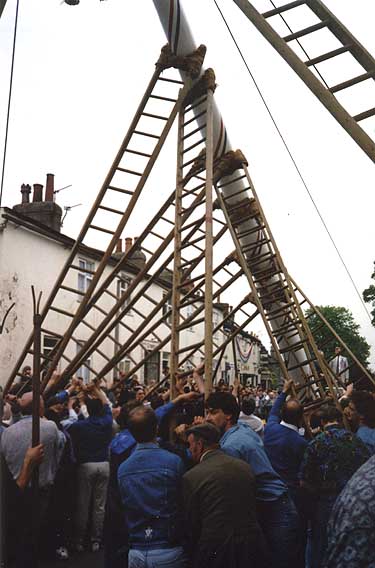
As well as repainting, the garlands were replaced. The garlands are made little ribbons with bells on - an old garland bell is a good luck charm, and I carried one as a key fob for many years. During the three weeks between Easter Monday and Whitsun, the new garlands are carried to every house in the village and touched for luck.
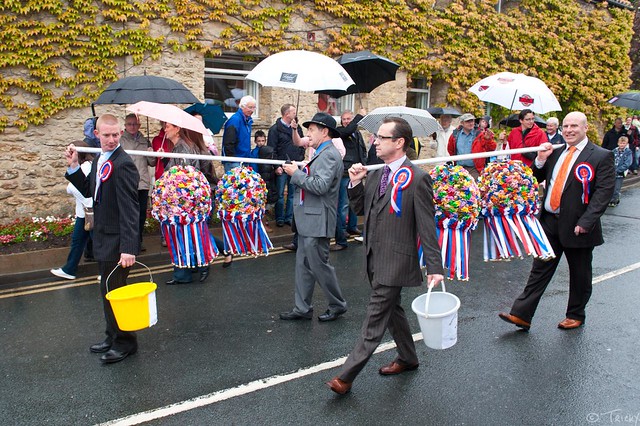
Several times, while it was down for repainting, lads from the neighbouring village of Aberford or the town of Garforth, stole the maypole in the middle of the night. Must have been a few of them - it takes a few score of people to carry the maypole. The most recent attempt was in 1966, when Aberford lads successfuly stole the top half 3 days before the maypole raising ceremony. Barwick had to quickly get a new top half and repaint it. The orginal was found the day before the ceremony - so for a few years, the village had a spare.
Maypole raising is done on Whitsunday, amid great celebrations at Hall Tower Hill, where crowds sit and watch the events. It's become something of a tourist attraction. Children from the village infant school dance around a smaller maypole (we practised for weeks when I did it). Older children from the junior school perform country dances (we practised for weeks when I did it). A village girl is chosen as May Queen and other children chosen as attendants (I was crown-bearer once). There's a fair. There is a lot of beer drunk. A lot of beer. There are marching bands, brass bands.
The maypole is raised in pretty much the reverse of how it's taken down. There's is one important difference - once the maypole is set in place, and the Maypole Climber ascends to remove the ropes, he must continue climbing to the very top of the maypole to spin the fox weathervane and bring luck to the village...
For many years, the maypole climber was my neighbour, Arthur Nicholls, who built a smaller maypole by his farmhouse to practice. I think that's him in the picture above.
The Day the Maypole FellEaster Monday, 1981, the maypole fell down Main Street while it was being lowered. I, aged 12, was on the Main Street rope with my sisters. I didn't quite realise what was happening at first - the rope went slack, the maypole seemed to be getting shorter, and then people started running. Fortunately, it landed in the street and everyone got clear. The tip hit the curb, and the top two feet broke off. A lad grabbed it (and the bent weathervane) and tried to make off with it, but one of my neighbours saw and brought him down in a rugby tackle a couple of hundred yards away.
These days, with much regret, the village uses a crane to raise and lower the maypole.
The next maypole raising will be at Whitsuntide, 2020, if you'd like to visit.
-
Looking over the thread, images I posted years ago of Gordale Scar and Malham Cove in Yorkshire never showed up. Gordale Scar is reputedly Tolkien's inspiration for Rivendell. The two locations are within walking distance of each other.
Gordale Scar

Malham Cove

To these I might add Troller's Gill, near Appletreewick in Yorkshire, home on local folklore to a Black Dog known as the Barghest (yes, that's the one that gives the name to the fantasy monster).

Also near Appletreewick, The Strid is a narrow, low gorge where the River Wharfe narrows to a point where it's possible to jump across - but people have died trying. The river here is some 30 feet deep, undercuts the rocks, moves with the speed of an express train, and the rocks around are slippy. Fall and you die. Strid Woods are a site of special scientific interest - an untouched upland oak forest. Half an hour's walk downstream of The Strid are the ruins of Bolton Abbey. From the far side of the Wharfe to the abbey, a path leads up to the Valley of Desolation, which is actually quite lovely - it's retained the name since a sotrm a couple of hundred years ago blew the trees down. They grew back.
The Strid
Strid Woods - looking downstream from The Strid.
.jpg)
Bolton Abbey. I've ancestors buried in that graveyard.

Posforth Gill, Valley of Desolation

Keep heading up the Valley of Desolation, and you'll climb Barden Fell to the natural viewpoint of Simon's Seat, with views over Upper Wharfedale.
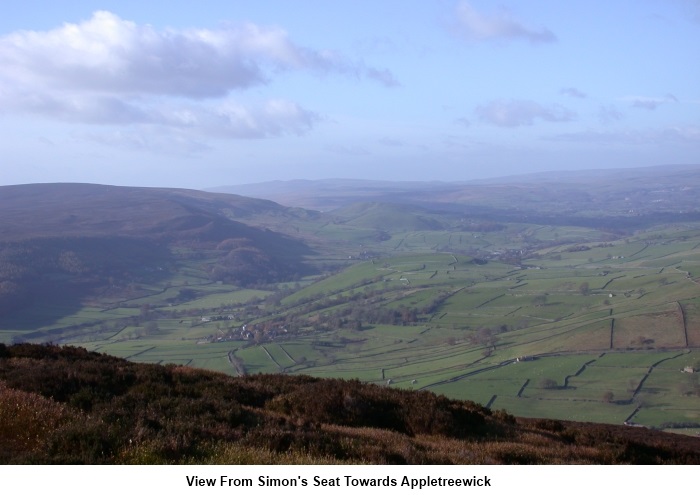
-
Held action. "I plant myself here and will let no one pass."
It's an issue common to all turn-based games - you're not actually standing still in the doorway unless you say so - you're already beginning your next action. We just break it down into turns to make actions easier.







Favourite Mediaeval Setting?
in Fantasy Hero
Posted
Less traditional works for me.
While I don't want to vary too much from the C&S model in the book, something of a change of emphasis is required. C&S magic (or magick if you prefer) is still quite high fantasy. Looking at works like Picatrix and the the Sworn Book of Honorious, many of the charms and rituals focus on commanding or dominating others, or on glamours/illusions. There aren't really any combat spells, or charms you can cast quickly within combat.
C&S has the command and illusion spells needed, but some of the flashier spells, including the combat ones, should be flagged to the GM as potentially genre-breaking.
With Col's Essence rules (which originated as an attempt to show you could capture the C&S atmosphere with greatly simplified rules), the field is much more open as there are only a few sample spells in the core rules, which are 10 pages long and free. Still, the emphasis will be as above.
That's a bit vague, I know. It's a section where I know what I want to achieve but haven't done the legwork yet.